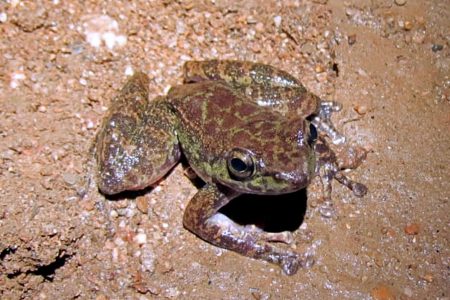Researchers from the Zoological Survey of India (ZSI) have discovered a new species of frog from deep inside a cave in Meghalaya’s South Garo Hills district which was recently published in an international journal, officials said on Tuesday.
Read here: This US scientist decided to live underwater for record-breaking 100 days. Why?
This discovery is the second time that a frog was discovered from inside a cave in the country, the first being the discovery of the Micrixalus spelunca in 2014 from a cave in Tamil Nadu, they said.
“Researchers from the Zoological Survey of India office here and the Pune-based ZSI have discovered a new species of cascade ranid frogs from deep within the Siju cave system in South Garo Hills district,” Bhaskar Saikia, one of the researchers told PTI.
Siju cave is a 4 km long natural limestone cave and the frog was discovered from about 60-100 meters deep in January 2020, a few months before the COVID-19 lockdown, he said.
The team named the new species as Amolops siju after the cave from where this discovery was made and the description of the new species was published in the latest issue of the international research journal, Journal of Animal Diversity published from Iran-based Lorestan University.
According to the ZSI official, since the frog, being morphologically cryptic in nature, tissue samples of the specimens were subjected to molecular studies to ascertain their specific identity from the other known species of other cascade Amolops frogs.
“Based on the morphological, molecular and the spatial data, the team concluded this population of frog from Siju cave as new to science and decided to name the new species after the cave Siju,” Saikia said.
While the specimens were collected from the twilight (60-100 m from cave entrance) and the dark zones (beyond 100 m of cave entrance) of the cave, the team did not find any troglobitic (cave adapted) modification, suggesting that this species of frog is not a permanent resident of the cave, he said.
According to Zoological survey of India officials, there have been reports of the presence of frog populations (up to 400 m from cave entrance) in Siju Cave since 1922 when the first bio speleological exploration of the cave was done by the ZSI.
“Intriguing as it may sound, the report of frog populations in a resource scarce, dark cave habitat over the course of a century is something that ecologists or biologists can take a note of,” he said, adding that the detritus food web and food chains of Siju cave is known to harbour more than 100 animal species, mostly invertebrates like cave crickets, spiders, beetles, earthworms.
With a mandate to survey and inventories the faunal diversity of the country, the ZSI’s discovery was a part of a research project on the faunal documentation of Siju Cave.
The researchers’ team also include Saikia and Dr Bikramjit Sinha from the ZSI office here besides Dr KP Dinesh and Shabnam Ansari of ZSI, Pune.
The team had also discovered three other new species of cascade frog (Amolops) in Arunachal Pradesh and those include the – Amolops chanakya, Amolops terraorchis and Amolops tawang.
Dr Dinesh said that the amphibian fauna of North eastern India is not fully explored and there is more potential of many more new species to be discovered from this ‘biogeographical fauna rich’ hotspot.
Read here: Why climate change is intimately tied to biodiversity
“The new species explorations are adding value to the biological wealth of the country where most of these species are endemic to small geographic landscapes,” he said.

